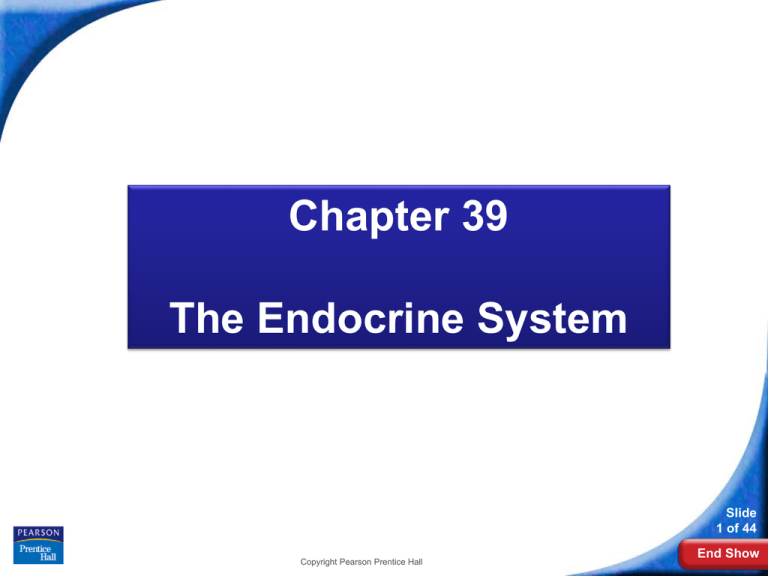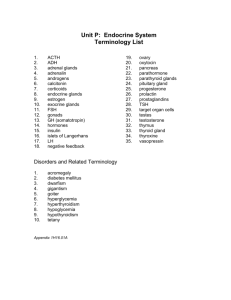
Biology
Chapter 39
The Endocrine System
Slide
1 of 44
Copyright Pearson Prentice Hall
End Show
What is the
function of the
endocrine
system?
To release hormones,
which send messages
throughout the body
via the blood stream.
Slide
2 of 44
Copyright Pearson Prentice Hall
End Show
What are
hormones?
Chemicals made &
released in one part of the
body that affect the cells
in OTHER parts of the
body.
Organs called GLANDS
make hormones
Slide
3 of 44
Copyright Pearson Prentice Hall
End Show
What do
hormones
do?
Hormones bind to specific
receptors on their TARGET
cells.
This changes the activity
of the target cells.
The effect can last from
minutes to days.
Slide
4 of 44
Copyright Pearson Prentice Hall
End Show
39-1
Cells that have receptors for a particular
hormone are called
a. nerve cells.
b. target cells.
c. exocrine cells.
d. endocrine cells.
Slide
5 of 44
End Show
Copyright Pearson Prentice Hall
39-1
Chemicals that travel through the bloodstream
and affect the activities of other cells are known
as
a. hormones.
b. receptors.
c. enzymes.
d. messengers.
Slide
6 of 44
End Show
Copyright Pearson Prentice Hall
39-1 The Endocrine System
Glands
DO NOT WRITE
ANYTHING. JUST READ
Hypothalamus
The hypothalamus makes
hormones that control the
pituitary gland. In addition,
the hypothalamus makes
hormones that are stored
in the pituitary gland.
Slide
7 of 44
Copyright Pearson Prentice Hall
End Show
39-1 The Endocrine System
Glands
Pituitary gland
The pituitary gland
produces hormones that
regulate many of the other
endocrine glands.
Slide
8 of 44
Copyright Pearson Prentice Hall
End Show
39-1 The Endocrine System
Glands
Parathyroid glands
The parathyroid glands
release parathyroid
hormone, which regulates
the level of calcium in the
blood.
Slide
9 of 44
Copyright Pearson Prentice Hall
End Show
39-1 The Endocrine System
Glands
Thymus
During childhood, the
thymus releases thymosin,
which stimulates T cell
development and proper
immune response.
This is important. Write it
down.
Slide
10 of 44
Copyright Pearson Prentice Hall
End Show
39-1 The Endocrine System
Glands
Adrenal glands
The adrenal glands
release adrenaline and
norepinephrine, which
help the body respond to
stress. (Fight or flight
response) Know this
one.
Slide
11 of 44
Copyright Pearson Prentice Hall
End Show
39-1 The Endocrine System
Glands
Testis
The testes produce
testosterone, which is
responsible for sperm
production and the
development of male
secondary sex
characteristics.
Slide
12 of 44
Copyright Pearson Prentice Hall
End Show
39-1 The Endocrine System
Glands
Ovary
Ovaries produce estrogen
and progesterone. Estrogen
is required for the
development of female
secondary sex characteristics
and for the development of
eggs. Progesterone prepares
the uterus for a fertilized egg.
Slide
13 of 44
Copyright Pearson Prentice Hall
End Show
39-1 The Endocrine System
Glands
Pancreas
The pancreas produces
insulin and glucagon,
which regulate the level
of glucose in the blood.
Slide
14 of 44
Copyright Pearson Prentice Hall
End Show
39-1 The Endocrine System
Glands
Thyroid
The thyroid produces
thyroxine, which regulates
metabolism throughout the
body.
Slide
15 of 44
Copyright Pearson Prentice Hall
End Show
39-1 The Endocrine System
Glands
Pineal gland
The pineal gland releases
melatonin, which is
involved in rhythmic
activities, such as daily
sleep-wake cycles.
Slide
16 of 44
Copyright Pearson Prentice Hall
End Show
39-1 The Endocrine System
How are
hormones
classified?
Some are STEROID
hormones made from a
lipid (fat) called cholesterol
Steroid hormones can
cross cell membranes
easily.
Slide
17 of 44
Copyright Pearson Prentice Hall
End Show
39-1 The Endocrine System
The Endocrine System
Steroid Hormone Action
Steroid hormone
Receptor
Nucleus
Hormone-receptor
complex: notice this
directly affects gene
expression.
Altered cellular
function
DNA
Protein
synthesis
mRNA
Copyright Pearson Prentice Hall
Slide
18 of 44
End Show
39-1 The Endocrine System
A steroid hormone
enters a cell directly
across its membrane.
The Endocrine System
Steroid hormone
It binds to a receptor
to form a hormonereceptor complex.
Receptor
Hormone-receptor
complex
Slide
19 of 44
Copyright Pearson Prentice Hall
End Show
39-1 The Endocrine System
The Endocrine System
The hormone-receptor
complex enters the
nucleus, where it binds
to a DNA control
sequence.
Binding initiates
transcription of genes to
mRNA.
DNA
Nucleus
mRNA
Slide
20 of 44
Copyright Pearson Prentice Hall
End Show
39-1 The Endocrine System
The Endocrine System
mRNA moves into the cytoplasm to direct protein
synthesis.
Altered cellular
function
Protein
synthesis
Slide
21 of 44
Copyright Pearson Prentice Hall
End Show
39-1 The Endocrine System
How are
hormones
classified?
Hormone Action
There are also nonsteroid
hormones which include
proteins, small peptides
and modified amino
acids.
Nonsteroid hormones
CANNOT pass through
the cell membrane.
Slide
22 of 44
Copyright Pearson Prentice Hall
End Show
39-1 The Endocrine System
The Endocrine System
Nonsteroid hormone
(first messenger)
A nonsteroid
hormone binds to
receptors ON THE
CELL MEMBRANE.
This activates an
enzyme on the
inside of the
membrane.
Slide
23 of 44
Copyright Pearson Prentice Hall
End Show
39-1 The Endocrine System
The Endocrine System
This enzyme
activates secondary
messengers that
carry the message of
the hormone inside
the cell.
These messengers
activate and inhibit
many cell activities.
ATP
cAMP
(second messenger)
Enzyme
activities
Altered
cellular
function
Slide
24 of 44
Copyright Pearson Prentice Hall
End Show
39-1 The Endocrine System
How does the
endocrine
system maintain
homeostasis?
The endocrine system is
regulated by FEEDBACK
mechanisms that
function to maintain
homeostasis.
Slide
25 of 44
Copyright Pearson Prentice Hall
End Show
39-1 The Endocrine System
What is an
example of
feedback
regulation
Control of the Endocrine System
The control of the metabolic
rate of your cells.
• Thyroxine (made by thyroid
gland) increases metabolic
rate.
• Probably affects ALL cells
of the body!
• Important for growth &
development.
Slide
26 of 44
Copyright Pearson Prentice Hall
End Show
Problems:
1. How will the body know it should
make more thyroxine?
2. How will it know when it has made
enough thyroxine?
Slide
27 of 44
Copyright Pearson Prentice Hall
End Show
39-1 The Endocrine System
Control of the Endocrine System
Book’s explanation (a bit much):
If thyroxine is low, the hypothalamus secretes
thyrotropin-releasing hormone (TRH), which
stimulates the anterior pituitary to secrete thyroidstimulating hormone (TSH).
TSH stimulates the release of thyroxine.
High levels of thyroxine in the blood inhibit secretion
of TRH and TSH, which stops the release of
additional thyroxine.
!!!!!
Slide
28 of 44
Copyright Pearson Prentice Hall
End Show
39-1 The Endocrine System
Negative feedback =
the output of a
pathway inhibits the
inputs to the pathway.
The end product
shuts off the
pathway that
makes that
product.
T3 & T4 are forms of
thyroxine
Slide
29 of 44
Copyright Pearson Prentice Hall
End Show
39-1 The Endocrine System
1
Control of the Endocrine System
7
Controlling
Metabolism 2
3
Don’t write
all of this
but DO
recognize
the negative
feedback
loop.
4
5
Slide
30 of 44
6
Copyright Pearson Prentice Hall
End Show
39-1
Which group of hormones act on target cells by
binding directly to DNA in the nucleus?
a. steroids
b. nonsteroids
c. proteins
d. second messengers
Slide
31 of 44
End Show
Copyright Pearson Prentice Hall
39-1
Metabolism is maintained by feedback loops
involving the
a. hypothalamus, gonads, and adrenal glands.
b. hypothalamus, anterior pituitary, and thyroid
gland.
c. anterior pituitary, pancreas, and thyroid
gland.
d. thyroid gland, parathyroid gland, and
pancreas.
Slide
32 of 44
End Show
Copyright Pearson Prentice Hall
39-1 The Endocrine System
What is the
function of
the pancreas?
A digestive gland whose
secretions help break
down food.
Also an endocrine gland which
makes INSULIN & GLUCAGON
These regulate levels of
blood sugar, glucose!
Slide
33 of 44
Copyright Pearson Prentice Hall
End Show
39-1 The Endocrine System
First, remember that foods you
eat are broken down and
converted to glucose (sugar)
What does the
hormone
INSULIN do?
Insulin: stimulates cells in muscle
& liver to REMOVE glucose from
bloodstream
• Glucose is then used right
away to make ATP
• OR liver converts and stores
it (short-term) as glycogen
• OR gets converted & stored
(long-term) as fat
Copyright Pearson Prentice Hall
Slide
34 of 44
End Show
39-1 The Endocrine System
What does the
opposite
hormone,
GLUCAGON
do?
Remember that glycogen: a SHORT
term storage form of glucose
Glucagon: stimulates cells in liver
to change glycogen back into
glucose and return it to
bloodstream when you need it.
Now the glucose is available as
fuel to create ATP.
Slide
35 of 44
Copyright Pearson Prentice Hall
End Show
39-1 The Endocrine System
What is
diabetes?
Show Mayo
Clinic video
clip.
Type I: an autoimmune disease
in which person does not
produce insulin.
Type II: a lifestyle disease
resulting from obesity. The
body makes insulin but the
cells are resistant to it.
(also gestational
diabetes = only
during pregnancy)
Copyright Pearson Prentice Hall
Slide
36 of 44
End Show
39-2
Diabetes mellitus is a disease that results when
the pancreas fails to produce or properly use
a. glucose.
b. insulin.
c. glucagon.
d. carbohydrate.
Slide
37 of 44
End Show
Copyright Pearson Prentice Hall
39-2
Metabolism is regulated by
a. thyroxine.
b. parathyroid hormone.
c. epinephrine.
d. estrogen.
Slide
38 of 44
End Show
Copyright Pearson Prentice Hall
39-2
The gonads are the body's
a. target cells.
b. exocrine glands.
c. reproductive glands.
d. reproductive cells.
Slide
39 of 44
End Show
Copyright Pearson Prentice Hall
39-2
Adrenaline (AKA epinephrine) is a hormone
produced by the adrenal medulla and is
responsible for
a. the “fight or flight” response to stress.
b. controlling the level of insulin in the blood.
c. maintaining proper levels of sodium and
potassium in the blood.
d. regulating the water content of the body.
Slide
40 of 44
End Show
Copyright Pearson Prentice Hall










